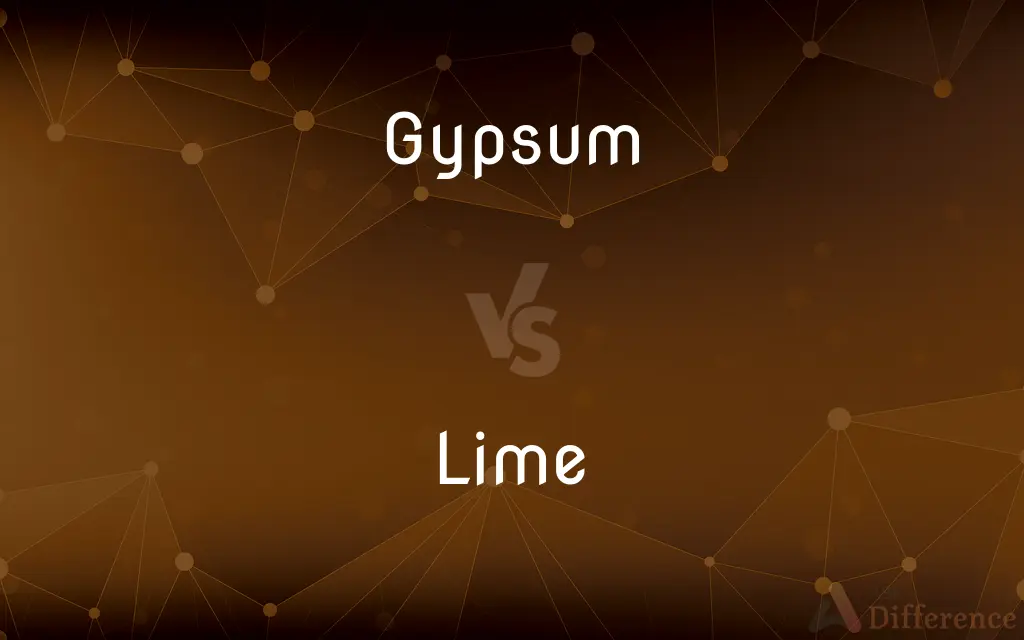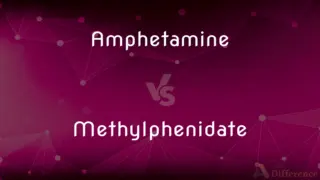Gypsum vs. Lime — What's the Difference?
By Tayyaba Rehman — Updated on October 27, 2023
Gypsum is a soft sulfate mineral, widely used in construction and agriculture. Lime is a calcium-containing inorganic material, used in construction, agriculture, and water treatment.

Difference Between Gypsum and Lime
Table of Contents
ADVERTISEMENT
Key Differences
Gypsum is a soft, white to colorless mineral composed primarily of calcium sulfate dihydrate. Lime, often referring to quicklime or hydrated lime, is a calcium-rich material derived from limestone.
While Gypsum is used in making plaster and drywall, Lime is key in cement and mortar production.
Gypsum helps improve soil structure and water penetration, whereas Lime adjusts soil pH and adds calcium.
Lime undergoes a heating process in its production, unlike Gypsum which is used directly in its mineral form.
Comparison Chart
Composition
Calcium sulfate dihydrate
Calcium oxide or calcium hydroxide
ADVERTISEMENT
Uses in Construction
Plaster, drywall
Cement, mortar, plaster
Agricultural Use
Soil conditioning, nutrient supply
Soil pH adjustment, nutrient supply
Physical Properties
Soft, can be scratched by fingernail
Harder, reactive with water
Processing
Mined and used directly
Derived from limestone and processed with heat
Compare with Definitions
Gypsum
Used for drywall and plasterboard.
They installed gypsum boards for the walls.
Lime
Material derived from calcined limestone.
Lime is integral in cement production.
Gypsum
Improves soil structure in agriculture.
Farmers add gypsum to enhance soil health.
Lime
Used to adjust soil pH in agriculture.
Adding lime can reduce soil acidity.
Gypsum
A key ingredient in plaster of Paris.
The artist used gypsum for the sculpture.
Lime
Essential in water treatment processes.
They used lime for purifying water.
Gypsum
A mineral composed of calcium sulfate.
Gypsum is essential in making plaster.
Lime
Reactive with water, producing heat.
Lime reacts exothermically with water.
Gypsum
Soft, white or colorless mineral.
Gypsum crystals are found in sedimentary rocks.
Lime
A white caustic alkaline substance consisting of calcium oxide, which is obtained by heating limestone and which combines with water with the production of much heat; quicklime.
Gypsum
Gypsum is a soft sulfate mineral composed of calcium sulfate dihydrate, with the chemical formula CaSO4·2H2O. It is widely mined and is used as a fertilizer and as the main constituent in many forms of plaster, blackboard/sidewalk chalk, and drywall. A massive fine-grained white or lightly tinted variety of gypsum, called alabaster, has been used for sculpture by many cultures including Ancient Egypt, Mesopotamia, Ancient Rome, the Byzantine Empire, and the Nottingham alabasters of Medieval England.
Lime
Birdlime.
Gypsum
A widespread colorless, white, or yellowish mineral, CaSO4·2H2O, used in the manufacture of plaster of Paris, various plaster products, and fertilizers.
Lime
A rounded citrus fruit similar to a lemon but greener, smaller, and with a distinctive acid flavour
Wedges of lime
Lime juice
Roughly chop two limes
Gypsum
A mineral consisting of hydrated calcium sulphate. When calcinated, it forms plaster of Paris.
Lime
The evergreen citrus tree which produces limes, widely cultivated in warm climates.
Gypsum
A mineral consisting of the hydrous sulphate of lime (calcium). When calcined, it forms plaster of Paris. Selenite is a transparent, crystalline variety; alabaster, a fine, white, massive variety.
Lime
A bright light green colour like that of a lime
A lime-green bikini
Gypsum
A common white or colorless mineral (hydrated calcium sulphate) used to make cements and plasters (especially plaster of Paris)
Lime
A deciduous tree with heart-shaped leaves and fragrant yellowish blossom, native to north temperate regions. The pale timber is used for carving and inexpensive furniture.
Lime
An informal social gathering characterized by semi-ritualized talking.
Lime
Treat (soil or water) with lime to reduce acidity and improve fertility or oxygen levels
They were liming acidified lakes
Lime
Catch (a bird) with birdlime
The bird that hath been limed in a bush
Lime
Sit or stand around talking with others
Boys and girls were liming along the roadside as if they didn't have anything to do
Lime
Any of several evergreen trees or shrubs of the genus Citrus having edible green or greenish-yellow fruit, especially the Mexican lime and the Persian lime.
Lime
The fruit of any of these plants, having a pulpy interior and usually acid juice.
Lime
See linden.
Lime
See calcium oxide.
Lime
Any of various mineral and industrial forms of calcium oxide differing chiefly in water content and percentage of constituents such as magnesia, silica, alumina, and iron.
Lime
Birdlime.
Lime
To treat with lime.
Lime
To smear with birdlime.
Lime
To catch or snare with or as if with birdlime.
Lime
(chemistry) Any inorganic material containing calcium, usually calcium oxide (quicklime) or calcium hydroxide (slaked lime).
Lime
(poetic) Any gluey or adhesive substance; something which traps or captures someone; sometimes a synonym for birdlime.
Lime
(theatre) A spotlight.
Lime
A deciduous tree of the genus Tilia, especially Tilia × europaea; the linden tree.
Lime
The wood of this tree.
Lime
Any of several green citrus fruit, somewhat smaller and sharper-tasting than a lemon.
Lime
Any of the trees that bear limes, especially Key lime, Citrus aurantiifolia.
Lime
(uncountable) A brilliant, sometimes yellowish, green colour associated with the fruits of a lime tree.
Lime
(fandom) A fan fiction story which contains sexual references, but stops short of full, explicit descriptions of sexual activity (coined by analogy with lemon).
Lime
A casual gathering to socialize.
Lime
(transitive) To treat with calcium hydroxide or calcium oxide (lime).
Lime
(transitive) To smear with birdlime.
Lime
(rare) To ensnare, catch, entrap.
Lime
(transitive) To apply limewash.
Lime
To hang out/socialize in an informal, relaxed environment, especially with friends, for example at a party or on the beach.
Lime
Containing lime or lime juice.
Lime
Having the aroma or flavor of lime.
Lime
Lime-green.
Lime
A thong by which a dog is led; a leash.
Lime
The linden tree. See Linden.
Lime
The fruit of the Citrus aurantifolia, allied to the lemon, but greener in color; also, the tree which bears it.
Lime
The color of the lime{1}, a yellowish-green.
Lime
Birdlime.
Like the limeThat foolish birds are caught with.
Lime
Oxide of calcium, CaO; the white or gray, caustic substance, usually called quicklime, obtained by calcining limestone or shells, the heat driving off carbon dioxide and leaving lime. It develops great heat when treated with water, forming slaked lime, and is an essential ingredient of cement, plastering, mortar, etc.
Lime
To smear with a viscous substance, as birdlime.
These twigs, in time, will come to be limed.
Lime
To entangle; to insnare.
We had limed ourselvesWith open eyes, and we must take the chance.
Lime
To treat with lime, or oxide or hydrate of calcium; to manure with lime; as, to lime hides for removing the hair; to lime sails in order to whiten them; to lime the lawn to decrease acidity of the soil.
Land may be improved by draining, marling, and liming.
Lime
To cement.
Lime
Having a yellowish-green color like that of the lime (the fruit).
Lime
A caustic substance produced by heating limestone
Lime
A white crystalline oxide used in the production of calcium hydroxide
Lime
A sticky adhesive that is smeared on small branches to capture small birds
Lime
Any of various related trees bearing limes
Lime
Any of various deciduous trees of the genus Tilia with heart-shaped leaves and drooping cymose clusters of yellowish often fragrant flowers; several yield valuable timber
Lime
The green acidic fruit of any of various lime trees
Lime
Spread birdlime on branches to catch birds
Lime
Cover with lime so as to induce growth;
Lime the lawn
Lime
Comes in forms like quicklime and hydrated lime.
Hydrated lime is used in mortar mix.
Common Curiosities
Can lime be used directly from limestone?
No, it needs to be processed by heating limestone.
Is gypsum harmful to plants?
Generally, no. It's beneficial for soil health.
Can gypsum be used to make cement?
Not directly, but it's an ingredient in some cement mixtures.
Does gypsum have industrial uses?
Yes, in manufacturing, agriculture, and food processing.
Is gypsum reactive with water?
Not significantly, unlike lime.
Is lime safe for gardening?
Yes, when used appropriately, it's safe and beneficial.
Can lime be used in food?
Yes, food-grade lime is used in certain culinary applications.
Do both improve soil fertility?
Indirectly, by improving soil conditions for plant growth.
Is gypsum only used in construction?
No, it's also used in agriculture and other industries.
Does lime always make soil alkaline?
It primarily neutralizes acidity, not always making it alkaline.
Can both be used to treat soil?
Yes, but for different purposes: gypsum for structure, lime for pH.
Are both materials naturally occurring?
Gypsum is, while lime is derived from natural limestone.
Is lime used in plaster making?
Yes, especially historically in lime plaster.
Can gypsum be found in crystal form?
Yes, it forms crystals in nature.
Does lime have any environmental applications?
Yes, in water treatment and flue gas desulfurization.
Share Your Discovery

Previous Comparison
Hymn vs. Anthem
Next Comparison
Amphetamine vs. MethylphenidateAuthor Spotlight
Written by
Tayyaba RehmanTayyaba Rehman is a distinguished writer, currently serving as a primary contributor to askdifference.com. As a researcher in semantics and etymology, Tayyaba's passion for the complexity of languages and their distinctions has found a perfect home on the platform. Tayyaba delves into the intricacies of language, distinguishing between commonly confused words and phrases, thereby providing clarity for readers worldwide.














































